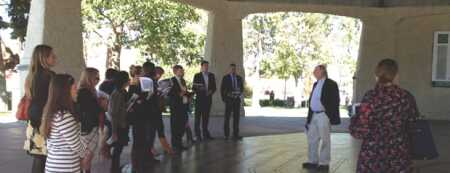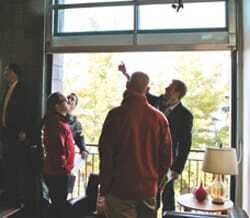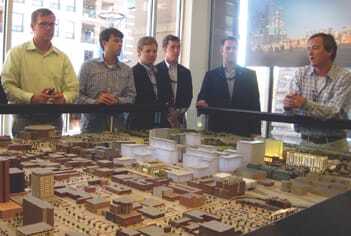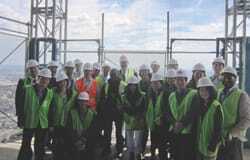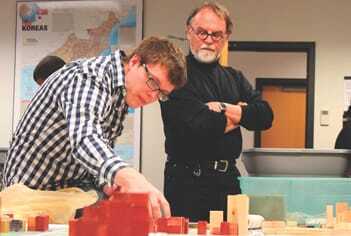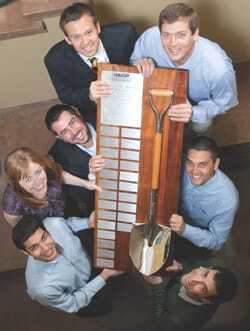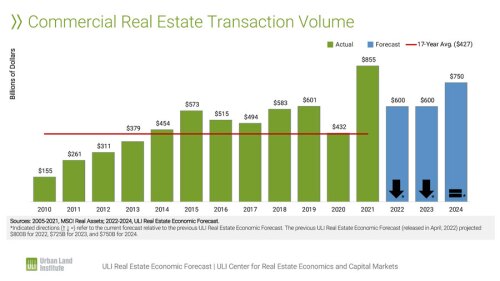| Related Articles: |
| Real Estate Education: The Online Option (2012) University Real Estate Programs: Maintaining Momentum (2011) Real Estate Education: Still on Course in a Crisis? (2010) |
For decades, universities in the United States tended to regard real estate development as a business enterprise—its purposes and methods to be taught in business schools—and focused primarily on ways and means of financing, constructing, and managing the sale or rental of projects and buildings. But times are changing. Last year’s Urban Land report on this subject (November/December 2011, page 90), described 21 university programs for real estate development and found them responding to evolving real estate processes that require fresh approaches and ideas.
Increasingly, successful real estate development demands practitioners who possess a broad spectrum of talents and skills for dealing with evolving trends in development products and processes. Changes in financing techniques, market opportunities, project and building design, environmental factors, and other concerns are reshaping approaches to planning and developing real estate.
Many universities are acknowledging these trends by establishing or reformulating courses in real estate development, aiming at increasing student understanding of the process and knowledge requirements. Frequently, real estate development programs now blend program coursework with broad access to courses in the university’s other schools and programs. This survey of 17 real estate programs is intended to expand the understanding and awareness of these trends. Survey findings indicate that most university real estate development curriculums have constructed interdisciplinary programs, many in collaboration with allied schools of the university. Indeed, some universities also have worked out cooperative relationships with programs of other universities to expand the reach of their real estate development curriculums.
Three striking conclusions can be drawn from this year’s evaluation of real estate programs:
- An expanding number of programs plan (some require) student forays to other cities and regions to learn “on the ground” from project developers about design excellence and the wide variety of development opportunities, as well as about project difficulties that almost invariably arise in real estate development.
- A growing number of university programs encourage students to seek some study abroad.
- The number of foreign students learning about American real estate development processes and outcomes appears to be rising.
Although the New York Times reported September 28 that new enrollment in U.S. graduate schools is declining, most university graduate-level real estate programs across America appear to be holding steady on enrollment or gaining students. This trend may reflect the growing revival of the real estate market in many communities, recognition of the increased complexities of the development process, or both. But it also may reflect the attraction that U.S. educational opportunities in real estate development holds for foreign students. This review of 15 programs not previously covered in Urban Land, plus updates on two programs described in 2011, indicates that learning about real estate development remains an attractive opportunity for many students.
The review, now in its third year, also reveals an increasing diversity of courses and on-the-ground education. Many programs are involving students in hands-on case studies in this country and abroad, and encouraging students’ facility with the latest computer programs. Also, though the majority of real estate programs are administered by business schools, other programs are found within or allied to architecture and planning departments, and a number feature joint programs between university schools. Most, if not all, allow substantial student access to a wide range of coursework in other schools within the universities. Another evident trend, which recognizes complexities in the marketplace and regulatory requirements, is attention in the curriculums to sustainability, mixed-use development and redevelopment, multiple transportation modes, and new-urbanist design ideas.
The university programs described here include five initiated within the past two or three years, five others established four to eight years ago with a substantial track record, and seven highly respected but varied programs established 20 to 52 years ago. All of the programs strongly reflect their intention to build on regional strengths and opportunities in real estate development past, present, and future.
Recently Established Programs and Approaches
Five programs established within the past four years illustrate the increasing interest universities have in broadening the scope of traditional real estate development programs to recognize current trends in urban markets and policy concerns. These relatively new programs exemplify the exciting variety of educational approaches to real estate development being pursued by many universities across the nation.
Tulane University’s Master of Sustainable Real Estate Development
Tulane’s real estate development curriculum in New Orleans was established by its School of Architecture in 2011. The program requires 43 credit hours featuring courses in sustainable urban design, along with instruction in the fundamentals of real estate development. Alexandra Stroud, the program’s director, emphasizes that the Tulane curriculum requires students to start with a six-week introductory summer session. They spend two weeks getting a grounding in basic financial and economic aspects of real estate development, followed by two weeks focused on the aims of sustainable development, and finishing with two weeks devoted to learning about development challenges and market forces in New Orleans. The full curriculum then requires 12 courses covering a mix of real estate, design, and hands-on study.
The city offers extraordinary opportunities for hands-on case studies in the rebuilding of housing, neighborhoods, and businesses, and for boosting students’ understanding of key factors such as density and environmental values.
The curriculum is enriched by seminars and lectures by industry practitioners from across the nation, including a Sustainability and Globalization lecture series sponsored by several organizations in New Orleans in addition to the School of Architecture. Also, the program has established an outreach component to support community assistance through the UrbanBuild, Regional Urban Development Center, and City Center programs that were established in response to damage in the city and region from Hurricane Katrina. In 2011, the Tulane program organized a trip to Washington, D.C., and New York City so students could experience firsthand the scale of and approaches to sustainability in those cities, with presentations by developers, planners, and architects involved in specific projects.
The planners of this relatively new curriculum say that a strong mix of basic coursework and learning about current practices in New Orleans and other cities provides an unusually broad understanding of the development process. In May 2012, 16 students graduated, and soon afterward a new class of 12 students had begun studies.
University of Washington’s Master of Science in Real Estate
The University of Washington, a state-supported school in Seattle, began organizing a real estate studies program in 2006 and initiated a master of science in real estate (MSRE) curriculum in 2009. The program is administered by the Runstad Center for Real Estate Studies, which was established in 2001 through an initial gift from Judy and Jon Runstad and attracted additional endowed funds from 250 individuals and other sources.
The MSRE curriculum offers a two-year academic degree for students earning 72 graduate credits. In 2012, 17 students received the MSRE degree, and 16 are expected to receive it in 2013. Professor George Rolfe says the MSRE program has admitted about 13 new students to begin this fall, and he expects the program to continue to attract students from other programs for specific classes. Generally, the MSRE courses attract about 20 students from the urban planning school, plus other students in business, engineering, and architecture curriculums.
The MSRE curriculum provides a “heavy dose of fundamental principles in developing real estate,” Rolfe says, and the Runstad Center continues to expand course offerings. First-year students in the program are assigned in groups of four to work with mentors—professional developers who introduce them to local and national real estate organizations and arrange visits to real estate projects in the Seattle area. Mentors are rotated among the groups for the program’s second year.
The Runstad Center also provides for a specialization in real estate (SRE) for students pursuing a master of urban planning degree. The SRE requires a minimum of 18 credits in real estate subjects. The specialization program is also extended to students accepted to other master’s degree programs at the university. Rolfe notes that students in the schools of engineering and architecture are especially responsive to this opportunity. Curriculums for the MSRE and SRE are integrated, accommodating a diverse group of students with common interests in real estate but different career objectives.
The Runstad Center also takes on research projects focused on real estate issues and problems, and organizes nondegree programs. For 23 years the center has sponsored a nondegree certificate in commercial real estate; classes taught twice weekly by skilled real estate professionals typically draw 20 to 30 students, generating hundreds of graduates over the years. Also, in 2011 the center initiated the Runstad Real Estate Research Fellows Program, which selects a mix of academics, professionals, and students to pursue research on a variety of development issues. The 2012 group, including two professors, two professional real estate practitioners, and two students just awarded their MSRE degrees, traveled to Istanbul to examine the development implications of its projected urban growth.
Update on the Evolution of Georgetown University’s Program
In Washington, D.C., Georgetown University continues to expand its robust real estate program initiated just three years ago and highlighted in the 2011 report in Urban Land. According to Charles Schilke, associate dean, the program is attracting more students—310 have signed up for the fall semester—and they can choose among 50 courses. Schilke says the program is graduating 120 to 130 students a year with master’s degrees in professional studies in real estate.
He maintains that real estate education, sometimes treated by business schools as a minor subject, is increasingly understood as a challenging and evolving field. This is due to a “revolution in construction methods, mounting environmental concerns, and increasingly complex funding mechanisms,” he says. In the Washington, D.C., region, real estate development has continued throughout the national downturn in project construction, although at a somewhat slower pace than before the recession. As developers in the region continue to build, many are using green development practices that call for up-to-date expertise.
Schilke notes that Georgetown was able to create a successful and expansive program relatively quickly due to the drawing power of the university’s national reputation, its central location in the booming Washington area, and the increasingly demanding complexities of real estate practice. Also, he points out that the school has benefited from the availability of a large cadre of skilled professionals willing to teach courses at the university’s central location near downtown Washington.
University of Utah’s Master of Real Estate Development Program
In 2007, the David Eccles School of Business at the University of Utah established the Ivory-Boyer Real Estate Center to promote real estate education and research in Utah. As one outcome of the center’s establishment, efforts were undertaken in cooperation with the College of Architecture and Planning to create a master of real estate development (MRED) curriculum. Arthur C. Nelson, the college’s presidential chair, worked with the Ivory-Boyer center to fashion the MRED program, which was approved in 2009 by the Utah State Board of Regents. The new program was designed to unite the real estate development process with the ideals of sustainability, while remaining mindful of the demands of real estate finance.
The program was designed for working professionals drawn to improving their expertise and who are attracted to courses in the late afternoon or evening. The degree requirement calls for completion of 42 semester credit hours. Students take 33 hours of core courses—five in finance and seven in real estate development subjects—plus nine credits in electives ranging from finance, design, and entrepreneurship to historic preservation, transportation, and sustainability.
In 2009, 23 students signed up for the program before it was officially approved. A year later, 15 students were accepted for the fall semester and ten for the spring. In 2011, 20 students began the program, and five more entered this past spring. Buzz W. Welch, who codirects the program with Nelson, says this level of interest is quite satisfactory on a yearly basis. He notes that until recently most students had been residents of Utah, but the current class has a more diverse geographic base.
Portland State University’s New Real Estate Program
Founded in 1946, Portland State University moved three times before settling in 1952 on a 50-acre (20 ha) campus in downtown Portland. A state school with nearly 30,000 students, it has the largest undergraduate and graduate enrollment of any university in Oregon and has attracted 1,700 international students from 91 countries. Its 60 undergraduate and 40 graduate programs confer 226 types of degrees.
Real estate degrees at Portland State range from an undergraduate real estate major or minor within the business administration program to an MRED initiated in 2012 as a joint program of the School of Business Administration and the School of Urban Studies and Planning. (Students can also opt for a real estate finance focus in the business school.) Most courses are taught in the evenings by adjunct professional experts in the field.
The MRED degree requires 68 credit hours in urban theory, finance, policy, and project development. The program aims to develop students’ skills needed to evaluate, create, implement, and manage real estate development and is designed to make extensive use of community and regional examples of sustainability-based development. To that end, students in the MRED program will participate in a real estate development workshop, working in teams to create a comprehensive development plan for a selected site. Though it is nominally a two-year program, part-time students can complete the curriculum in two and a half years. For the fall 2012 semester, the MRED program attracted 14 students.
In addition, the university offers a real estate development certificate requiring 29 credits at the graduate level, which may count toward requirements for master’s and PhD programs. Courses are also available to qualify for a professional license.
Evolving Programs Drawing Attention
Five university programs in real estate development established from 2004 to 2008 are focusing on small classes and a variety of courses and activities to generate broadly knowledgeable graduates.
Clemson University’s MRED
Clemson University is located near the Blue Ridge Mountains in Clemson, South Carolina. To the town’s nearly 14,000 year-round inhabitants, the university adds almost 19,000 students during the school year. Its MRED program was established in 2004 as a joint degree venture by the architecture and business schools. Such pairings of university resources are increasingly attractive because they afford students access to an impressive range of courses and opportunities to study development in action.
Professor Robert Benedict describes the two-year full-time program as a “full-immersion, hands-on experience” for yearly classes currently limited to 20 students. The curriculum is fashioned to encourage students to “become champions of responsible development and sustainable growth within the context of economic feasibility and value creation.” Students must complete at least 54 credit hours, including basic courses in business, law, and real estate finance, plus courses focusing on critical aspects of development such as human settlement patterns, new construction technologies for design and construction, strategic planning for development, and principles of real estate practice. (Students who have taken undergraduate courses in some of these subjects may substitute electives in a variety of disciplines.)
At the end of the first year, students set out on a “development tour” to cities such as Atlanta, Charlotte, and Savannah—even as far away as Denver—to learn firsthand about development projects from the developers. Instead of ending the second year with a final exam, students work together through a supervised practicum focused on a specific development opportunity in a nearby city. According to Benedict, the combination of “book learning” and access to practical, on-the-ground experiences is the key to understanding the development process.
University of Illinois at Chicago
In 2004, the Keller Graduate School of the University of Illinois at Chicago launched a collaborative master of arts in real estate (MRE) program supported by the College of Business Administration and the College of Urban Planning and Public Affairs. The curriculum offers courses in economics, finance, and urban planning. MRE students can major in either business or planning. The university’s location in Chicago allows students to use the city as a laboratory for learning about urban real estate markets. Obtaining the MRE degree requires at least 36 semester hours of graduate credit. Seven courses totaling 27 hours (in economics, finance, urban development, land use law, and professional topics) are required. In addition, students choose two courses totaling eight hours from either the business concentration of four courses or the urban planning concentration of five courses.
Teaching occurs in evening classes intended to serve professionals working in either public or private sectors of urban real estate. In 2006, 41 students completed the two-year program and graduated with MRE degrees. More recently, the program has graduated about 15 students per year, and Thomas Bothen, director of the MRE program, could confirm only eight students entering the program in fall 2012.
The College of Urban Planning also offers a PhD program for advanced study of urban development, blending urban planning and public policy concerns with the practice of real estate development. Currently including 31 students, it requires at least 96 semester hours of graduate credit beyond the baccalaureate, or generally 64 additional hours after receipt of the MRE degree.
In addition, urban planning faculty and students can conduct both theoretical and applied research through the college’s seven research centers, institutes, and laboratories, such as the Great Cities Institute and the Voorhees Center for Neighborhood and Community Improvement. The Great Cities Institute, for example, attracts 15 to 20 students every year to conduct research concerning urban development issues in the Chicago region and elsewhere.
University of Miami’s Variety of Options in Real Estate Education
The University of Miami, a private research university, has 12 schools and colleges serving more than 15,000 undergraduate and graduate students in more than 180 majors and programs. Perhaps because the university was founded in 1925 during the region’s early real estate boom, it has had a strong interest in educating students in the science and art of real estate development. The School of Business offers several options for obtaining a master of business administration (MBA) degree in real estate development:
- a two-year concentration in real estate within the business curriculum that requires a basic real estate finance course and three additional courses, two of which may be in the School of Architecture;
- a joint program with the schools of Architecture and Law that culminates in a master of real estate development and urbanism degree (MRED+U); and
- a partnership with the School of Architecture that allows students to earn a bachelor of architecture degree while obtaining a master of business administration degree. With two internship opportunities, it requires six years to complete both degree programs.
The business school’s two-year real estate concentration generally attracts about ten students a year, and requires a real estate finance course and three electives in real estate law, investment and appraisal, and project management and modeling.
In 2008, the one-year interdisciplinary program that leads to the MRED+U was initiated by the schools of Business, Architecture, and Law. Now attracting an average of 20 students and administered by the School of Architecture, the program combines fundamental aspects of real estate development with livable community planning and design. The curriculum incorporates case studies of mixed-use development, urban infill development, redevelopment, historic preservation, and the integration of design, policy, management, and decision making in shaping communities’ built environments. Charles Bohl, who oversees the MRED-U program, highlights the value of a culminating charrette in which students apply their skills in design and development to a prospective, real-world project.
The MRED+U program is also the host of executive education training programs and offers a variety of short courses, such as classes for nondevelopers and training in use of MS Excel and in conducting charrettes. In addition, it offers an online, 55-hour course in the principles and practice of new urbanism.
The School of Business is now working with the School of Architecture to launch an accelerated program in 2013 to be focused on commercial development. It will begin with an internship, and another internship will follow between the first and second semesters; it also will provide consulting opportunities with nonprofit real estate organizations.
University of St. Thomas’s MSRE Curriculum
The University of St. Thomas, established in 1885, maintains campuses in downtown Minneapolis and St. Paul, Minnesota. Most of its 13,000 students reside within the extensive Twin Cities metropolitan area, which has a population of 3.2 million and an active market for development. Founded as a Roman Catholic institution, the school considers its mission to be inspired by the Catholic intellectual tradition.
The university established an undergraduate real estate program in 1995, which currently has 37 students aiming to obtain a bachelor of science degree in real estate in the Opus College of Business. In 2002, the university initiated a program for obtaining an MSRE degree, which currently has 34 students, most already working in real estate. The university says the MSRE can be completed in 24 months for students working full time, or an accelerated 16-month program can be completed by taking classes in summer and January terms, as well as fall and spring semesters.
The MSRE curriculum calls for completion of ten three-credit core courses and a six-credit capstone option either to complete a thesis course or two elective courses such as corporate or international real estate or business courses offered by the Opus College of Business graduate programs. Students take part in group exercises and case studies, and because many students are already working in the industry, they learn from each other as well. The Shenehon Center for Real Estate holds conferences dealing with real estate issues and publishes a monthly report on the housing market in the Twin Cities.
Marquette University’s Undergraduate Real Estate Program
Marquette University is an institution of 13,000 students located in Milwaukee. In 2002, it brought PhD Mark Eppli to occupy the Bell Chair in Real Estate, with the primary mission of organizing and overseeing an undergraduate real estate curriculum. The program began in 2003, graduates about 25 students each year, and currently has 60 students taking courses. It offers a broad education mindful of ethical ideals. All students at Marquette must complete 12 core courses (36 credit hours) that range from such subjects as rhetoric and mathematical reasoning to diverse cultures, literature/performing arts, and theology.
Upon completion of these courses, students can turn to meeting course requirements for the undergraduate major in commercial real estate in the College of Business Administration. The curriculum requires two core courses in real estate principles and finance, plus three electives from 13 specialized courses in real estate and finance (including an internship possibility) and four business electives, for a total of 39 credits. Courses are taught by professionals in the real estate field and take advantage of classroom, on-site, and off-site experiences. Students can participate in an on-campus real estate organization, as well as other industry organizations. The program sponsors quarterly lectures in cooperation with regional organizations. An advisory group made up of 180 real estate and related professionals meets semiannually, and members assist with curriculum, placement, financial, and teaching needs.
Long-Established Schools Continuing to Break New Ground
The following seven university programs feature a variety of approaches for educating students about real estate. They range from the ten-month, highly intensive program at the Massachusetts Institute of Technology (MIT) limited to 25 students, to the University of California, Berkeley’s two-year MBA program that attracts about 70 students per year and features substantial interaction with the community. Rutgers’s master of city and regional planning combines a variety of programs bearing on development, while Portland State University’s MRED program is a joint venture of its Business School and College of Urban Studies and Planning.
MIT’s Center for Urban Real Estate
Established in 1984, the intensive one-year program at MIT leading to a master of science in real estate development (MSRED) degree quickly became one of the most respected curriculums in real estate education. Rather than insist on an initial year of general business coursework, MIT’s Center for Urban Real Estate focuses directly on the “real estate asset and its related disciplines,” drawing on many MIT resources, including the schools of architecture and planning, engineering, economics, and management. In 2012, the school moved into new and renovated spaces in a central location at the university.
Professor David Geltner says the program tends to attract students with previous experience in the business of development who have “a practical mindset” and are committed to building better living and working environments. The curriculum was designed for 25 students; typically about one-third have already earned master’s degrees. About one-third come from outside the United States.
The curriculum begins in the fall with a two-week orientation, followed by 11 months of intensive full-time study and ending with a thesis—altogether taking the equivalent of about two and a half semesters. Core courses scheduled for weekly meetings often meet again within the week to reach closure on difficult subjects. For the first semester in the 2011–2012 school year, core courses included real estate finance and investment, real estate economics, a special seminar on real estate products, and one of four elective courses—negotiating new ventures, introductory urban design, mixed-income housing, or land use policy. The spring courses focus on complex urban projects and capital markets, plus two electives in negotiating techniques, innovative project delivery, or analytical tools for making design decisions. During this period, students bond in a “tight cohort” promoting team building in an international context, notes Professor Tod McGrath. The curriculum ends with individual thesis projects and presentations.
The center also sponsors lectures by well-known professionals in real estate. In 2012, the center joined with the Sloan Real Estate Club to sponsor a symposium that attracted nearly 160 researchers and practitioners from the Boston region. In addition, the center offers what it terms “finance boot camps"—two-day summer courses—and a range of short courses for real estate professionals.
University of San Diego Programs in Real Estate Development
The University of San Diego was created in 1979 by the union of two colleges established as Roman Catholic institutions. Today, the university draws more than 800 faculty members and 7,800 students to its 180-acre (316 ha) campus. The School of Business Administration provides an undergraduate real estate major that requires 15 units in real estate after completion of basic business courses. At the graduate level, the Burnham-Moores Center for Real Estate focuses on teaching a ten-month concentration (or 22 months or less for part-time students) for an MSRE degree. Typically attracting 20 to 25 students, the graduate program this year has 17 students, two of whom are in a dual degree program.
The curriculum requires 32 units of coursework in areas that include real estate law and public policy, real estate market analysis, design and construction management, negotiations and ethical issues, and sustainable real estate. The curriculum ends with a capstone project that typically involves the whole class in analyzing a development opportunity in the San Diego area and framing a workable proposal. One recent project involved constructing a public/private parking facility under a public park, and addressing design, economic implications (both public and private), and other issues. The curriculum increasingly reflects concerns about sustainability and green practices, including a three-day training period concerning the Leadership in Energy and Environmental Design (LEED) rating system.
The School of Business Administration also offers an MBA-MSRE dual degree program that requires 74 units of coursework and two practicums, which can be completed in two school years and a fall or summer session. The program requires 14 hours of community service, a professional development course, leadership labs, and an internship or other work experience during the program. Also offered is an international MBA-MSRE program that makes some alterations to the dual degree program.
Northwestern University’s Kellogg School Real Estate Program
Located in Evanston, Illinois, bordering Chicago, Northwestern University has offered a real estate program through the Kellogg School of Management for 25 years. Students can choose a major in real estate among many options—such as marketing and international business—and receive their MBAs from the Kellogg School. In addition, students in the McCormick School of Engineering and Architecture can take real estate courses at Kellogg.
About 300 students a year take real estate courses in the program, though the number of students working toward a major in the real estate program has fallen in recent years to about 30 from 60 earlier. Almost all classes are taught on weeknights so part-time students can work toward the master’s degree.
Real estate students gain considerably from Northwestern’s location in the Chicago area, which, with its lively real estate scene, enables the school to work closely with local real estate companies. Some classes essentially serve as lab courses in which students interact with real estate companies to carry out research on specific investment and development issues and present their findings to the companies. One course, the Real Estate Challenge, is organized as a competition with students at the University of Chicago Booth School of Business and focuses on evaluating a specific development or investment opportunity. In addition, Northwestern students plan a yearly Chicago-area real estate conference, and twice a year students organize visits to real estate companies in other cities to learn about their operations and local projects.
Northwestern students benefit from support from the Guthrie Center for Real Estate Research, created in 1995. The Guthrie Center works with the Kellogg School’s real estate faculty and students on research projects that involve real estate markets, public and private finance, project management, and the development process. The center also helps students find summer and full-time employment.
Georgia State University’s MSRE and Other Programs
Georgia State University, founded in 1913, occupies a large campus in downtown Atlanta and offers 60 graduate and undergraduate programs for about 30,000 students. In 2006, the university began a $1 billion campus expansion planned to include a new building for the J. Mack Robinson College of Business.
For 52 years, the Department of Real Estate within the business school has offered a broad range of programs to prepare students “to deal in land assets as investors, brokers, appraisers, analysts, financiers, or developers,” according to the online program description. The department administers an undergraduate program that currently attracts about 100 students to earn a bachelor of business administration degree in real estate or a minor in real estate development.
Graduate students can work toward an MSRE, an MBA major or concentration in real estate, or a hotel real estate concentration in real estate. The master’s curriculum requires 27 semester hours in nine basic real estate courses and nine hours in three elective courses. According to Professor Jon Wiley, the master’s programs are enrolling 25 to 30 graduate students a year—fewer during the current recession than was the case in previous years. Fifteen to 20 percent of students in the master’s curriculums come from foreign countries.
Classes in real estate development are taught by accomplished researchers and experienced real estate professionals, Wiley says. Their teaching combines theory with a practical orientation intended to encourage student participation in analytical, problem-solving approaches. A doctoral program also is offered, currently with seven students working toward a PhD in real estate. The college also sponsors a nondegree certificate in real estate.
Wiley credits the strength of the program to the pull of the Atlanta area. He estimates that a majority of the real estate graduates come from the Atlanta area and that as many as 80 to 90 percent will continue to live in Georgia. “There’s so much going on in this region,” he says, “with a relatively strong economy, an attractive airport, MARTA [Metropolitan Atlanta Rapid Transit Authority], the new greenbelt, and lots of room for growth"—all factors that generate a strong real estate job market. Wiley also stresses the strong support of graduates who remain engaged in real estate in the state and region, many of whom lecture in the department’s courses.
Rutgers University Program in Urban Planning and Policy Development
Founded in 1776, Rutgers University in New Jersey became a state university in 1945 and currently oversees three campuses and more than 175 academic departments that serve over 60,000 students. The Rutgers program in urban planning and policy development, in the Edward J. Bloustein School of Planning and Public Policy, bridges the typical divides between public regulatory processes and market approaches to urban and suburban real estate development.
The master’s planning program, established in 1967, is one of the largest in the country, with about 190 students. Robert Burchell, chair of urban planning and policy development and director of the Center for Urban Policy Research at Rutgers, emphasizes that the program combines a focus on social concerns with analytic skills in diverse disciplines with the goal of meeting the needs of students with varying interests. Rutgers students learn about public regulatory aspects of development and how market forces must be factored into the equation to yield desirable—and profitable—community development.
The master of city and regional planning degree requires 24 credits provided by a planning history and theory class, an urban economic and special patterns class, three courses in methods of planning analysis, two planning studios, and a survey of planning law, plus 24 credits of electives, 12 of which are required in a specific concentration. Students wishing to focus on the housing and real estate concentration—one of five concentrations available—select three of seven three-credit courses offered on housing principles and land development practice, residential and commercial finance and investment analysis, land use administration, historic preservation, and green building techniques. They must also take one course in urban redevelopment, economic redevelopment, housing analysis, or public finance.
The school’s other areas of concentration are transportation planning, environmental and physical planning, international development, and urban and community development. In addition, options for students include a master’s degree in public policy, undergraduate degrees in planning and public policy, and a doctoral degree in planning and public policy. Most students are given a stipend to support their studies, and employment opportunities are available to conduct hands-on research in one of the school’s centers and institutes.
Johns Hopkins University’s Edward St. John Real Estate Program
Johns Hopkins University’s Carey Business School launched a real estate curriculum 22 years ago with evening classes in Baltimore and Washington, D.C. Like similar programs at other universities, the school intended to make it possible for students to acquire an advanced degree while working in full-time jobs. The part-time MSRE curriculum is designed so that students can take evening courses and complete the program in two years. Michael Anikeeff, who heads the real estate program, says more than 720 students have graduated from the part-time program, and most continue to live and work in the Washington/Baltimore region.
The Hopkins program also has established an accelerated, full-time master of science degree with a 12-month course of study, taught by Johns Hopkins professors and practitioners drawn from experts in the region’s investment, development, law, architecture, and planning fields. The program includes courses and workshops particularly oriented to the project development process. During the summer, students participate in internships to gain hands-on experience. Currently, 31 full-time students, two-thirds from other countries, are engaged in the program. The accelerated full-time MSRE curriculum, launched five years ago, has graduated 77 students.
Hopkins also offers an MBA with a concentration in real estate, requiring five eight-week terms of core business courses, followed by courses in real estate. The MBA students may complete academic requirements in three years, or up to six years if necessary. Currently, the MBA curriculum is offered in Columbia and Rockville, Maryland, as well as Baltimore and Washington, D.C.
University of California, Berkeley’s Real Estate Program
The real estate curriculums at Berkeley are lodged within the Haas School of Business, which offers several real estate courses for students working toward an MBA. The Haas School also administers undergraduate programs for a bachelor of science degree or a global management concentration, and offers a PhD program.
The Haas School aims to enroll about 240 students in the MBA program every year. Each student enters a two-year full-time program with courses in development, finance, law, and planning that provide a foundation in qualitative, quantitative, analytical, strategic, and problem-solving skills. Students can choose about 60 percent of their curriculum from elective courses, but each student must take at least one experiential course in innovative leader development.
One such course—quite popular—is an introduction to real estate investment analysis, building on core classwork such as finance and economics and focusing on real cases. Professor Nancy Wallace, California Chair of Real Estate and Urban Economics, who oversees the course, organizes students into teams of five or six. Each team is challenged to propose development solutions for an actual real estate investment property and its owner or client. Students undertake extensive face-to-face interactions with stakeholders, professional real estate and design experts, and capital providers to frame the development problem, identify opportunities, and apply innovative revenue models. Each team must manage ambiguity and conflict, generate creative solutions, and pursue adaptive forms of governance. Stakeholders often play an active role in determining a final proposal and presentation.
Projects for this class are identified in cooperation with the city of Berkeley departments of Economic Development and City Planning, a city council member, and the university’s Berkeley Foundation. Each project proposal generated by the students is required to include a detailed financial package and meet all the land use requirements for the site. In the spring 2012 course, students dealt with large parcels in the city suitable for technology office parks, startup office space, housing, hotels, and retail uses; they also considered the economic merits of privatizing two proposed student housing developments on campus. Recognizing the difficulties of dealing with historic sites in need of seismic repairs, Wallace recruited student architects from the College of Environmental Design to work with the teams.
Project examples included a proposal for the condemned Old City Hall that requires $17 million in seismic upgrades. The team proposed that the city finance seismic improvements based on future income from the building’s proposed redevelopment as a boutique hotel. Funding proposals for the retrofit included subordinating room taxes and the ground lease to a note issued by the city. Another project involved residential zoning for the historic stable for fire engine horses. The team retained the stable for city office use, but for the surrounding acreage came up with the concept of locating container housing on small lots—a financially innovative idea consistent with current market dynamics and the historic requirements of the site.
Students also participate in activities sponsored by the Berkeley Real Estate Club, the Accelerating Careers in Real Estate Program, and the Fisher Center for Real Estate & Urban Economics.
Final Thoughts
Mark J. Reidy, head of the Burnham-Moores Center for Real Estate, founded in 1983 at the University of San Diego, commented in a recent center newsletter that for many years questions about “the need for and academic legitimacy of real estate curricula haunted start-up programs and slowed their growth.” He recalled that many successful executives who had learned their craft through on-the-job training questioned the value of a formal education in their discipline. Now, he writes, “the benefits of formal academic studies in real estate have been widely recognized.”
Certainly the benefits of educating smart, knowledgeable, and capable real estate practitioners are becoming more evident as the goals and realities of urban development are changing with new lifestyles, technical advances, and concerns about sustainable forms of development. This sampling of current university real estate programs indicates that educational resources for producing knowledgeable real estate professionals are widely available in a variety of formats. Moreover, such programs have gained respect as invaluable contributors to building exciting, livable urban places.

